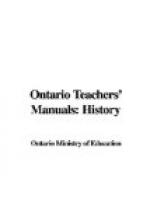HISTORY AND CONSTRUCTIVE WORK
Constructive work may be used to advantage in history and civics. It gives concrete expression to some facts of history through the construction by the pupils of objects mentioned therein. In studying Indian life, the class may make in paper, wood, etc., wigwams, bows and arrows, stockades, etc.; in connection with pioneer life, they may make some of the buildings and implements used by the pioneers,—log houses, spinning-wheels, hominy blocks, Red River carts, etc.; in studying campaigns, they may make models in plasticine or clay, or on the sand table, of forts, battle-fields, etc., for example—the Plains of Abraham, Queenston Heights, Chateauguay, Plymouth Harbour; the Union Jack may be cut out and coloured. (See p. 68.) In this way the activities of the child may be made of practical use.
On the industrial and social side of history, which is being more and more emphasized, it is of great value to the child to become acquainted, even though on a small scale and through the simplest implements and machines, with the construction of machinery and modes of manufacture. For a lesson on the Industrial Revolution in England, for example, it will give pupils a better understanding of the changes, if they know something, through their own activities, of the way of making cloth.
For suggestions on constructive work, see the Manual on Manual Training:
P. 22: Suggestions
for the various seasons and days.
P. 26: On the use
of the sand table.
P. 55: On collecting
and preserving pictures.
P. 58: On relief
maps and geographical formations.
HISTORY AND ART
Art assists history in two ways. First, pictures may be used to illustrate events in history and make them real. It is often difficult for children to form a definite mental image of historical scenes merely from the words of the teacher or of the text-book, because their experiences are limited and the power to combine these properly is lacking. This is recognized now in the many text-books which are freely illustrated. Pictures of persons famous in history are also of value, in that they make these persons more real to the pupils. Materials for class use may be collected by the teacher and pupils,—engravings, prints, cuts from newspapers and magazines of famous people, buildings, cities, monuments, events; for example, the Landing of Columbus, the Coming of the Loyalists, the Fathers of Confederation, the Landing of the Pilgrim Fathers, an Old-Time Trading Post, the Death of Brock. A good idea is to have a class scrap-book, to be filled with suitable contributions from the class. The teacher will find a private scrap-book exceedingly useful. Many fine pictures are given in The Highroads of History, and The Story of the British People for Form III. It may be added that these pictures should be supplemented freely by descriptions and narratives given by the teacher. (See Visual Aids in the Teaching of History.)




